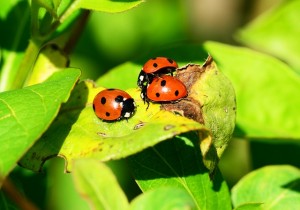“So, being a ladybug automatically makes me a girl; is that it?” — Denis Leary as Francis in A Bug’s Life.
Ladybugs are good luck. Don’t kill them, or it will bring you bad luck. Whether it’s an old wives’ tale, or whether it is superstition, many disagree. A contrarian view, especially for those who have hundreds of ladybugs overwintering in their homes: kill them all.
 But they’re beneficial, right? Entomologists, farmers and many others make this claim. They certainly are beneficial in that they help control insects on crops, feeding on sap-sucking aphids, which are known to destroy plants. In addition to feasting on aphids, they find whiteflies, scale insects, and many other plant pests to be delicacies.
But they’re beneficial, right? Entomologists, farmers and many others make this claim. They certainly are beneficial in that they help control insects on crops, feeding on sap-sucking aphids, which are known to destroy plants. In addition to feasting on aphids, they find whiteflies, scale insects, and many other plant pests to be delicacies.
They’re also pretty, sporting colors of orange, red, black, and sometimes a touch of blue. Pretty, and predatorial. They also help pollinated plants. To reiterate, for those of you who like the letter P, ladybugs are: pretty, predatorial pollinators of plants but can also be perpetual pests.
Unwelcome Winter Tenants
Also known as lady asian beetles, these bugs are not “beneficial” when they enter homes. When temperature drops and fields have been harvested, lady asian beetles seek shelter, flying to warm structures to board up for the winter. They don’t do much in the home, except annoy people with their presence. They can bite hard enough to pierce the skin, but the bites are rare.
Native to Asia, Lady Asian beetles (Harmonia axyridis) were first imported to America in 1916 to control certain plant pests. It was first released in a few locations, but now it is found almost everywhere.
Morphology:
Lady beetles are a little bit larger than the native ladybugs in America. Generally, the beetle has 19 black spots on its elytra (outer hard wings). Some beetles might have less than 19 spots and a few might have no spots at all. The most distinct identifying characteristic of the beetle is that it has a “M” shaped marking behind its head, black in color. Larvae are also black with two orange stripes on the body.
Biology:
Like other Ladybugs in America, Lady Asian Beetles also feed on soft-bodied insect pests of various plants in gardens and lawns. There are four distinct life stages of Ladybugs: egg, larvae, pupae, and adult. These adult beetles appear in early spring. Females start laying eggs on the leaves of host plants which hatch in about 3-5 days. As the larvae emerge, they start crawling on the leaves and search for aphids and other soft-bodied insects to which to feed. Each larva undergoes four moltings and then is pupated in an immobile stage. After about 4-7 days, the pupae emerge into an adult. Depending upon food and temperature, the life cycle is completed in almost 2-3 weeks.
Pest status:
Lady Asian bugs do not do damage structures as do other pests such as termites, ants, wasps, and other insects do. They neither chew clothes or other material, nor do the larvae crawl in various places to cause annoyance. They mostly stay in the cracks and crevices of walls but become a nuisance if they enter the living area of homes.
Prevention and control:
The very first and best approach to prevent these beetles from coming into your dwelling is to keep them out by keeping windows closed and all the cracks sealed. Sweeping and vacuuming is another effective method to remove these bugs from your home. Light attacks Lady Asian bugs. Thus, you may use light traps to kill the bugs which enter your living areas. As the beetle is not a “pest” in homes, it is not recommended to use pesticides in homes for its eradication.
Interesting facts:
- Lady Asian Beetles are also known as The halloween lady beetle because they invade homes in the Fall, sometimes in late October, searching for warm structures in which to overwinter. Why aren’t more kids dressing up as ladybugs on Halloween?
- The name of the family of ladybug is “Coccinellidae”, which means “little red sphere.”
- Because ladybugs are predators of many pests, they are considered the “farmer’s friend.”
- It is a common myth that the spots on the back of ladybugs are the age of the insect.
- Not all ladybugs have spots on them.
- The variety of colors of ladybugs is actually a warning to other insects that they do not taste good.
- The spots on ladybugs fade as they get older.
- Ladybugs clean themselves after they take a meal.
- Not all ladybugs are female.

